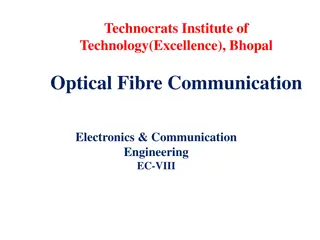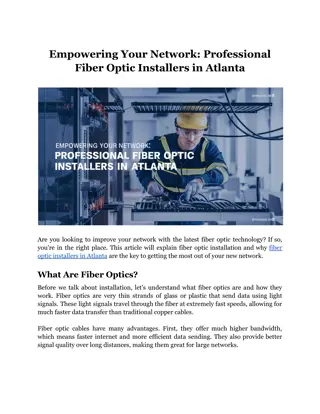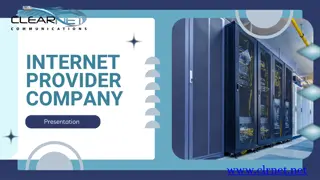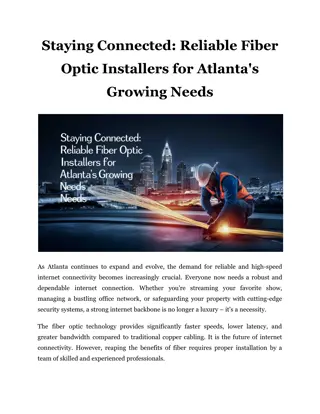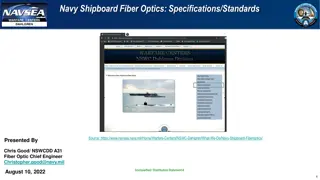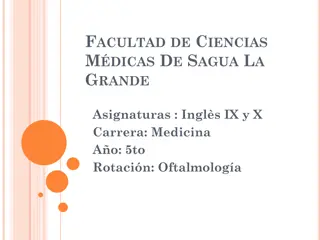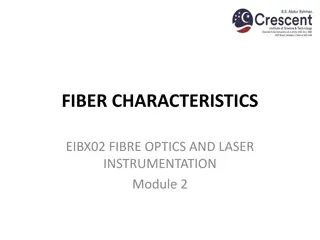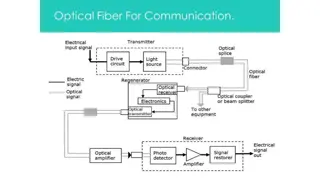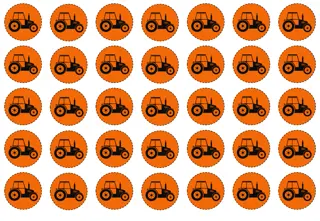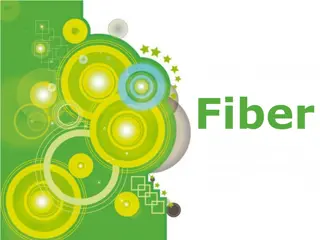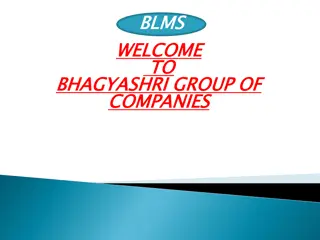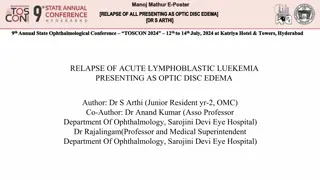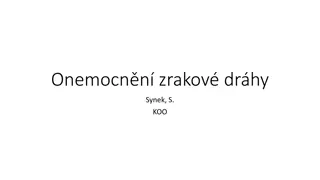Overview of Point-to-Point Fiber Optic Communication System
Point-to-point fiber optic communication systems involve converting voice signals from a microphone into digital signals using a coder, transmitting light signals through a semiconductor diode laser over optical fibers, and decoding the signals back to analog for sound production. The system offers advantages like high information capacity, low cost materials, and lightweight portability but also faces limitations such as maintenance costs and signal loss due to fiber bending. Additionally, a numerical example is provided for calculating the minimum allowable refractive index for cladding in an optical fiber setup.
Download Presentation

Please find below an Image/Link to download the presentation.
The content on the website is provided AS IS for your information and personal use only. It may not be sold, licensed, or shared on other websites without obtaining consent from the author.If you encounter any issues during the download, it is possible that the publisher has removed the file from their server.
You are allowed to download the files provided on this website for personal or commercial use, subject to the condition that they are used lawfully. All files are the property of their respective owners.
The content on the website is provided AS IS for your information and personal use only. It may not be sold, licensed, or shared on other websites without obtaining consent from the author.
E N D
Presentation Transcript
Block diagram of point to point fiber optic communication system: The microphone in the telephone receiver converts voice in to equivalent analog electrical signals. The analog signals are converted in to digital signals using a coder. A transmitter consisting of a semiconductor diode laser which emits light according to the digital binary input. The light emitted from the laser source is launched on the optical fiber.
The information in the form of light can be transmitted over large distances. If necessary, repeaters can be used. A repeater, receives the signal and amplifies it and transmit again. At the receiving end the photodiode convert the received light in to equivalent binary electrical signals.
The decoder converts binary electrical signal in to analog electrical signals. The loud speaker in the handset produces sound waves to convey the voice information.
Advantages(Merits) of optical communication system: Optical fibers can carry very large amount of information, whose frequencies are spread over a large bandwidth. Material used for making the optical fibers are available in low cost. Because of their compactness and lightweight, optical fibers much easier to transport. Since the signal is optical, there is no short circuit happen as it could be in the case of electrical signal (wire).
Limitations(demerits) of optical communication system: Splicing is a skilful task. The escalation of maintenance cost. The loss of signal is become considerable one when we bent the fibers into beyond critical bending.
Numerical examples 1. An optic fiber of RI 1.50 is to be clad to ensure TIR that will contain light travelling with in ?? of the fiber axis. What minimum RI is allowed for the cladding? Given: RI of Core ??= 1.5 The light rays are travelling with in ?? wrt fiber axis ??= ?? RI OF cladding ??= ? B C Cladding ?? Core ?? ? = ??? 1 =?? O The ray travelling at ?? will have min angle of incidence and those with lesser angle, have still greater angle of incidence. To calculate minimum RI allowed for cladding, one has to apply Snell s Law. Let us assume this ray, travelling at ??wrt fiber axis, grazes the core clad interface
Numerical examples 1. An optic fiber of RI 1.50 is to be clad to ensure TIR that will contain light travelling with in ?? of the fiber axis. What minimum RI is allowed for the cladding? B C Cladding ?? Core ?? ? = ??? 1 =?? O Appling Snell s law at B, we have ??sin?? = ??sin?? Or ??= ?.? ?.??? = ?.??? Ie. If Cladding have a RI 1.494, the ray travelling at ?? wrt axis f the fiber grazes the interface. Thus, minimum RI is allowed for the cladding such that the light travelling with in ??ensure TIR should be less than 1.494
Numerical examples 2. The angle of acceptance of an optical fiber is ??? when kept in air. Find the acceptance angle when the same fiber is immersed in water of RI 1.33 Given: RI of air ??= ?, Acceptance angle ??= ??? RI of water ??= ?.?? Acceptance angle ??=? When the fiber is in air, NA =sin??= ?????? When the fiber is in water, sin?? ?0 ??= sin ??.??? = ???? sin 300 1.33 ?.? 1.33= 0.376 NA =sin??= = = When the same fiber is immersed in water, the acceptance angle reduces to ???.
Numerical examples 3. Calculate the V- number for a fiber of core diameter 40 m & RI of 1.55 and 1.50 respectively for its core & cladding when a light of wavelength 1400nm is propagating. Also calculate the number of modes that the fiber can support for the propagation. Given: RI of Core ??= ?.??, RI of cladding ??= ?.?? Core diameter d = 40 m, wavelength of light =1400nm. ?=? & N =? The V Number is given by V =?? ?? ? =? ?? ?? ? ???? ?? ? V = 35.05 ? = 89.76 ? ?? ?.??? ?.??? ?? No of Modes N =?? ?=??.??? = ???.? ? V parameter is 35 & the no of modes that fiber can support is 312
Numerical examples 4. The attenuation in optical fiber is 3.6dB/Km. What fraction of its initial intensity remain after 1.5Km Given: Attenuation coefficient = 3.6dB/Km. Length of fiber L = 1.5K Fractional intensity at the receiving end ?? ??=? ?? ?log?? ?? ?? ?? ?? ?? Attenuation coefficient ? = ??= log?? ??= ?? ?? ?? = ?? ?.? ?.? ?? Or = ?? ?.??=0.29 ?? At the receiving end 29% of its initial intensity is received.



